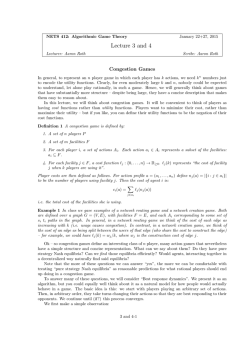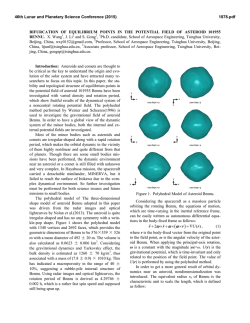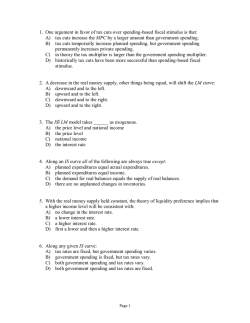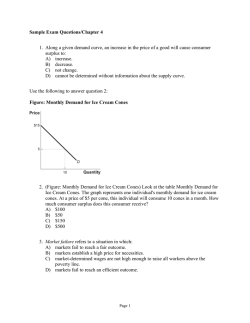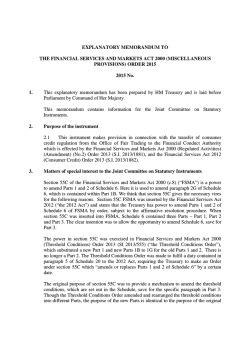
paper
Correlated equilibria in homogenous good Bertrand competition∗ Ole Jann and Christoph Schottmu ¨ller† January 29, 2015 Abstract We show that there is a unique correlated equilibrium, identical to the unique Nash equilibrium, in the classic Bertrand oligopoly model with homogenous goods and identical marginal costs. This provides a theoretical underpinning for the socalled “Bertrand paradox” as well as its most general formulation to date. Our proof generalizes to asymmetric marginal costs and arbitrarily many players in the following way: The market price cannot be higher than the second lowest marginal cost in any correlated equilibrium. JEL: C72, D43, L13 Keywords: Bertrand paradox, correlated equilibrium, price competition 1. Introduction A substantial body of theory in industrial organization and other fields of economics is built on the idea that there are no equilibria with positive expected profits in a simple Bertrand competition model with homogenous goods and symmetric firms—in other ∗ The authors would like to thank one anonymous referee and the editor (Atsushi Kajii) for helpful suggestions. We have also benefitted from comments by Jan Boone, Gregory Pavlov and Peter Norman Sørensen. † Address to both authors: Department of Economics, University of Copenhagen, Øster Farimagsgade 5, Building 26, DK-1353 Copenhagen K, Denmark; email: [email protected]. 1 [email protected] and words, that there are no profitable cartels and that price competition between n > 1 firms will drive prices down to marginal cost in one-shot price competition. The fact that price competition between two firms is equivalent to perfect competition is often referred to as the “Bertrand paradox”. Yet the theoretical foundation for this idea is not fully clear, especially where correlated equilibria are concerned. In a correlated equilibrium, players can construct a correlation device which gives each player a private recommendation before the players choose their actions. In correlated equilibrium, the device is such that it is an equilibrium for the players to follow the recommendation. Every (mixed strategy) Nash equilibrium is a correlated equilibrium where the recommendations are independent. Players can in many games achieve higher payoffs in correlated equilibrium than in Nash equilibrium because the device is able to correlate recommendations; see Aumann (1974). In Bertrand competition, it is conceivable that players could correlate their prices in such a way as to achieve high prices while still (through the shape of the joint price distribution) making sure that none of them wants to deviate. We show that this is not possible, although the argument is somewhat subtle. More precisely, we show that no correlated equilibrium (and hence also no mixed Nash equilibrium) with positive expected profits can exist in a symmetric Bertrand game with homogenous products and bounded monopoly profits.1 This is the most general formulation of the Bertrand paradox yet. Our result is certainly desirable because a statement like the Bertrand paradox – implying that zero profits are inevitable in a price competition setting – should naturally be shown using an equilibrium concept that is “permissive”, i.e. a solution concept that allows the players to coordinate as much as possible within the paradigm of a one-shot, non-cooperative game. This is exactly what correlated equilibrium does.2 Our result is not obvious given that the set of rationalizable 1 Wu (2008) claims to prove a similar theorem for symmetric linear costs and linear demand. Note, however, that he does not provide a proof for the central second case in his case distinction and implicitly limits his analysis to a finite action space which is incompatible with the standard version of the Bertrand game. 2 Correlated equilibrium has been shown to have many other attractive properties as well: For example, several simple learning procedures converge to correlated equilibria, see for example Foster and Vohra (1997), Fudenberg and Levine (1999), Hart and Mas-Colell (2000), and unique correlated equilibria are robust to introducing incomplete information, see Kajii and Morris (1997). It should, 2 actions is large: In symmetric, homogenous good Bertrand competition all non-negative prices are rationalizable.3 This is, for example, in stark contrast to Bertrand games with differentiated products: Milgrom and Roberts (1990) show for a large class of demand functions that there is a unique rationalizable action in a differentiated goods Bertrand game. This clearly implies that there is a unique Nash equilibrium and also a unique correlated equilibrium in these games. Their reasoning, however, applies only to supermodular games. A Bertrand game with homogenous goods is not supermodular since the profit functions (i) do not have increasing differences and (ii) are not order upper semi-continuous in the firm’s price. Our proof is by contradiction: We show that if there was a correlated equilibrium in which prices higher than marginal cost were played with positive probability, then there would be an interval of recommendations in which each player prefers to deviate downwardly from his recommendation. This interval consists of the highest recommendations that a player might get (with positive probability) in the assumed equilibrium. The contribution of this paper lies in the proof that in Bertrand games with arbitrary demand functions (in which the set of rationalizable actions is infinite), the Bertrand Nash equilibrium is the unique correlated equilibrium. Apart from that, it is also a generalization (by different methods) of results of Baye and Morgan (1999) and Kaplan and Wettstein (2000) on mixed-strategy equilibria in Bertrand games. Baye and Morgan (1999) show that if monopoly profits are unbounded, any positive finite payoff vector can be achieved in a symmetric mixed-strategy Nash equilibrium, and Kaplan and Wettstein (2000) prove that unboundedness of monopoly profits is both necessary and sufficient for the existence of such mixed-strategy Nash equilibria. These insights have led Klemperer (2003, section 5.1) to conclude that “there are other equilibria with large profits, for some standard demand curves.” We show that expected profits in any correlated equilibrium (and therefore in any mixed Nash equilibrium) are zero if demand is such that monopoly profits are bounded. Finally, unlike the cited results, our proof is generalizable to games with asymmetric costs and arbitrarily many players: We show that the highest market price in any correlated equilibrium however, be noted that these papers limit themselves to finite games for technical reasons. 3 Every pi ∈ R+ is in our model rationalizable because pi is – assuming zero marginal costs – a best response to pj = 0 which is the Bertrand equilibrium price and therefore itself rationalizable. 3 equals the second lowest marginal cost. This establishes an (outcome) equivalence of Nash and correlated equilibria also in this more general setup. A related result is derived in Liu (1996). Liu shows that the unique Nash equilibrium in Cournot competition with linear demand and constant marginal costs is also the unique correlated equilibrium. This paper is organized as follows. The next section introduces the Bertrand model with two symmetric firms as well as the concept of correlated equilibrium. Section 3 derives our result. This result is generalized for the case of n non-symmetric firms in section 4. Section 5 concludes. 2. Model There are two firms with constant marginal costs which are normalized to zero. Firms set prices simultaneously. The price of firm i is denoted by pi . If pi < pj , consumers buy quantity D(pi ) of the good from firm i (and 0 units from firm j). If both firms quote the same price p0 , consumers buy D(p0 )/2 from each firm. D(p) denotes market demand where D : R+ → R+ is a (weakly) decreasing, measurable function and R+ denotes the non-negative real numbers. We assume that the demand function is such that a strictly positive monopoly price arg maxp pD(p) exists. We define pmon as the supremum of all prices maximizing pD(p) and assume that pmon is finite. Firms maximize expected profits. A correlated equilibrium in this game is a probability distribution F on R+ × R+ . This probability distribution is interpreted as a correlation device. The correlation device sends recommended prices (r1 , r2 ) to the two firms. Each firm i observes ri but does not observe the other firm’s recommendation rj . F (p1 , p2 ) is the probability that (r1 , r2 ) ≤ (p1 , p2 ). Roughly speaking, a distribution F is called a correlated equilibrium if both firms find it optimal to follow the recommendation. To be more precise denote the profits of firm i given prices pi and pj with i, j ∈ {1, 2} 4 and i 6= j as pi D(pi ) πi (pi , pj ) = pi D(pi )/2 0 if pi < pj if pi = pj (1) else. Note that we define the profit function such that the own price is the first argument, i.e. the first argument of π2 is p2 . A strategy for firm i is a mapping from “recommendations” to prices. Both recommendations and prices are in R+ . Hence, a strategy is a measurable function ζi : R+ → R+ . The identity function represents the strategy of following the recommendation. F is a correlated equilibrium if no firm can gain by unilaterally deviating from a situation where both firms use ζi = identity function. More formally, we follow the definition of correlated equilibrium for infinite games given in Hart and Schmeidler (1989) and also used in Liu (1996): A correlated equilibrium is a distribution F on R+ × R+ such that for all measurable functions ζi : R+ → R+ and all i ∈ {1, 2} and i 6= j ∈ {1, 2} the following inequality holds: Z πi (pi , pj ) − πi (ζi (pi ), pj ) dF (p1 , p2 ) ≥ 0. (2) R+ ×R+ In words, a distribution F is a correlated equilibrium if no player can achieve a higher expected payoff by unilaterally deviating to a strategy ζi instead of simply following the recommendation. Last, we define a symmetric correlated equilibrium as a correlated equilibrium F in which F (p1 , p2 ) = F (p2 , p1 ) for all (p1 , p2 ) ∈ R+ × R+ . It is well known that both firms set prices equal to zero in the unique Nash equilibrium of this game (usually this is called “Bertrand equilibrium”); see, for example, Kaplan and Wettstein (2000). 3. Analysis and Result We start the analysis by noting that whenever there is a correlated equilibrium F then there is a symmetric correlated equilibrium G in which the aggregated expected profits are the same as in F . This result is, of course, due to the symmetry of our setup. It 5 will allow us later on to focus on symmetric correlated equilibria.4 Lemma 1. Let F be a correlated equilibrium. Then there exists a symmetric correlated equilibrium G such that Z Z π1 (p1 , p2 ) + π2 (p2 , p1 ) dF (p1 , p2 ) = R+ ×R+ π1 (p1 , p2 ) + π2 (p2 , p1 ) dG(p1 , p2 ). R+ ×R+ Proof. Let F be a correlated equilibrium. Define F˜ (p1 , p2 ) = F (p2 , p1 ). Then, F˜ is also a correlated equilibrium as for any measurable function ζ : R+ → R+ Z πi (pi , pj ) − πi (ζ(pi ), pj ) dF˜ (p1 , p2 ) ZR+ ×R+ πi (pj , pi ) − πi (ζ(pj ), pi ) dF (p1 , p2 ) = R+ ×R+ Z = πj (pj , pi ) − πj (ζ(pj ), pi ) dF (p1 , p2 ) ≥ 0 R+ ×R+ where the first equality holds by the definition of F˜ , the second holds by the symmetry of the setup, i.e. π1 (x, y) = π2 (x, y), and the inequality holds as F is a correlated equilibrium. Define G(p1 , p2 ) = 21 F (p1 , p2 ) + 12 F˜ (p1 , p2 ). Then G is a correlated equilibrium as for any measurable function ζ : R+ → R+ Z πi (pi , pj ) − πi (ζ(pi ), pj ) dG(p1 , p2 ) R+ ×R+ Z 1 = πi (pi , pj ) − πi (ζ(pi ), pj ) dF (p1 , p2 ) 2 R+ ×R+ Z 1 1 1 + πi (pi , pj ) − πi (ζ(pi ), pj ) dF˜ (p1 , p2 ) ≥ 0 + 0 = 0 2 R+ ×R+ 2 2 where the equality follows from the definition of G and the inequality follows from the fact that F and F˜ are correlated equilibria. Clearly, G is symmetric as G(p1 , p2 ) = 1 F (p1 , p2 ) 2 4 + 12 F˜ (p1 , p2 ) = 12 F (p1 , p2 ) + 12 F (p2 , p1 ) = 12 F˜ (p2 , p1 ) + 21 F (p2 , p1 ) = G(p2 , p1 ) Intuitively, we make use of the fact that the set of correlated equilibria in this game is convex—as could be shown by generalizing the following lemma with arbitrary weights instead of 6 1 2 and 12 . by the definition of G and F˜ . Finally, expected profits under F and G are the same as Z π1 (p1 , p2 ) + π2 (p2 , p1 ) dG(p1 , p2 ) R+ ×R+ Z Z 1 1 = π1 (p1 , p2 ) + π2 (p2 , p1 ) dF (p1 , p2 ) + π1 (p2 , p1 ) + π2 (p1 , p2 ) dF (p1 , p2 ) 2 R+ ×R+ 2 R+ ×R+ Z Z 1 1 = π1 (p1 , p2 ) + π2 (p2 , p1 ) dF (p1 , p2 ) + π2 (p2 , p1 ) + π1 (p1 , p2 ) dF (p1 , p2 ) 2 R+ ×R+ 2 R+ ×R+ Z π1 (p1 , p2 ) + π2 (p2 , p1 ) dF (p1 , p2 ) = R+ ×R+ where the first equality follows from the definition of G and F˜ and the second equality follows from the symmetry of setup, i.e. π1 (x, y) = π2 (x, y). Let F be a symmetric correlated equilibrium. Define p¯ := inf{p0 : R (p0 ,∞)2 dF (p1 , p2 ) = 0}. Intuitively, p¯ is the price such that (i) the probability that the market price is greater than pˆ is strictly positive for any pˆ < p¯ and (ii) the probability that the market price is greater than pˆ is zero for any pˆ > p¯. That is, if we consider the distribution of prices that consumers pay in the correlated equilibrium F , p¯ is the essential supremum of this “market price distribution”. The following lemma establishes that p¯ exists by showing R that (pmon ,∞)2 dF (p1 , p2 ) = 0 in any correlated equilibrium F . This implies p¯ ≤ pmon and consequently a finite p¯ exists. The intuitive reason for lemma 2 is that setting prices above pmon is a weakly dominated strategy. Lemma 2. In a correlated equilibrium F , R (pmon ,∞)2 dF (p1 , p2 ) = 0. Proof. Consider the strategy ζ1 (r1 ) = r1 if r1 ≤ pmon p ∗ if r1 > pmon , where p∗ ∈ arg maxp∈R+ pD(p), i.e. p∗ ≤ pmon is an arbitrary monopoly price. Firm 1’s payoff difference between following the recommendation and using the deviation strategy ζ1 is Z ∗ Z ∗ [π1 (p1 , p2 ) − p D(p )] dF (p1 , p2 ) + (pmon ,∞)×(p∗ ,∞) −p∗ D(p∗ )/2 dF (p1 , p2 ). (pmon ,∞)×{p∗ } The integrand of the first integral is strictly negative as p∗ D(p∗ ) = maxp∈R+ pD(p) and larger than the profit at any price above pmon . The second integral is non-positive. ConR sequently, F can only be a correlated equilibrium, i.e. satisfy (2), if (pmon ,∞)×(p∗ ,∞) dF (p1 , p2 ) = R 0 which implies (pmon ,∞)2 dF (p1 , p2 ) = 0 by p∗ ≤ pmon . 7 Before we proceed, it is useful to define the following sets which will serve as the domain of integration multiple times in the following proofs. For some pˆ ∈ (0, p¯) and ε ∈ (0, 1), define the sets A(ˆ p) = {(p1 , p2 ) : p1 ∈ (ˆ p, p¯] and p2 ∈ [p1 , p¯]} B(ˆ p) = {(p0 , p0 ) : pˆ < p0 ≤ p¯} C(ˆ p, ε) = {(p1 , p2 ) : p1 ∈ (ˆ p, p¯] and p2 ∈ [εp1 , p¯]} E(ˆ p) = {(p1 , p2 ) : p1 ∈ (ˆ p, p¯] and p2 ∈ [ˆ p, p¯]} E 0 (ˆ p) = {(p1 , p2 ) : p1 ∈ (ˆ p, p¯] and p2 ∈ (ˆ p, p¯]}. Figure 1 depicts the sets. p2 p¯ p2 p2 p¯ p¯ A(ˆ p) E(ˆ p) pˆ pˆ p1 p¯ pˆ pˆ 3 C(ˆ p, 10 ) pˆ p¯ p1 pˆ p¯ Figure 1: A(ˆ p) is shown in panel 1, while B(ˆ p) is simply the diagonal between (ˆ p, pˆ) and (¯ p, p¯), including the latter but not the former point. Panel 2 shows C(ˆ p, 0.3). Panel 3 0 shows E(ˆ p); E (ˆ p) is identical to E(ˆ p) except that the border where p2 = pˆ is not part of the set. It follows immediately from the definition of p¯ and the symmetry of the setup that R A(ˆ p) dF (p1 , p2 ) > 0 for any pˆ ∈ (0, p¯).5 That is, a firm deviating by charging pˆ < p¯ given any recommendation will sell with positive probability. This observation will be important later on. The following lemma shows that there is no probability mass on the diagonal of the distribution F above (ˆ p, pˆ) if F is a symmetric correlated equilibrium. This is 5 To be precise, note that R p1 ∈(p, ˆ p), ¯ p2 >p¯ dF (p1 , p2 ) = 0 in any correlated equilibrium F : Otherwise, firm 2 could profitably deviate by setting p2 = pˆ whenever receiving a recommendation above p¯ (while following recommendations below p¯). 8 p1 quite intuitive: The diagonal represents situations in which both firms get the same recommendation. Hence, each firm could discontinuously increase its profits by lowering the price only slightly (thereby capturing all instead of half of the demand) in this situation. If the event that both firms get the same recommendation above pˆ had positive probability mass, each firm could therefore gain by deviating to a price slightly below its recommendation whenever it receives a recommendation above pˆ. Lemma 3. Let F be a symmetric correlated equilibrium. Then, R B(ˆ p) dF (p1 , p2 ) = 0 for any pˆ ∈ (0, p¯). Proof. The proof is by contradiction. Suppose to the contrary that R B(ˆ p) dF (p1 , p2 ) > 0. Recall that π1 is discontinuous at points on the diagonal of the (p1 , p2 ) plane. Therefore, (2) is violated for ζ ε (r1 ) = r1 if r1 6∈ (ˆ p, p¯] εr1 if r1 ∈ (ˆ p, p¯] for ε ∈ (0, 1) sufficiently close to 1: Firm 1’s payoff difference between following the recommendation and playing ζ ε can be written as Z Z π1 (εp1 , p2 ) dF (p1 , p2 ) π1 (p1 , p2 ) dF (p1 , p2 ) − ∆ = C(ˆ p,ε) A(ˆ p) Z Z −π1 (εp1 , p2 ) dF (p1 , p2 ) π1 (p1 , p2 ) − π1 (εp1 , p2 ) dF (p1 , p2 ) + = C(ˆ p,ε)\A(ˆ p) A(ˆ p)\B(ˆ p) Z p1 D(p1 ) − εp1 D(εp1 ) dF (p1 , p2 ). + 2 B(ˆ p) The first term continuously approaches 0 as ε % 1. To see this, note that the first R term is (weakly) less than (1 − ε) A(ˆp)\B(ˆp) π1 (p1 , p2 )dF (p1 , p2 ) because p1 < p2 in A(ˆ p) \ B(ˆ p). The second term is non-positive and the third term is strictly negative and R bounded away from 0 as ε % 1 because B(ˆp) dF (p1 , p2 ) > 0. Consequently, ∆ < 0 for sufficiently high ε < 1. This contradicts that F is a correlated equilibrium and therefore R dF (p1 , p2 ) = 0 has to hold. B(ˆ p) After this auxiliary result, we come to the main result: In any correlated equilibrium, both firms set prices equal to zero with probability 1 and therefore make zero profits. That is, every correlated equilibrium is essentially equivalent to the Bertrand Nash equilibrium.6 6 The qualifier “essentially” stems from the definition of correlated equilibrium in infinite games: A 9 The intuition behind this result is the following: Take a symmetric correlated equilibrium and suppose that p¯ > 0. Take some pˆ ∈ (0, p¯). If a firm, say firm 1, deviates by charging pˆ instead of its recommendation whenever firm 1 receives a recommendation above pˆ, there are two effects of the deviation: If r1 > r2 > pˆ, firm 1 gains pˆ because it sells while it would not have sold by following the recommendation. If r2 > r1 > pˆ, firm 1 loses r1 − pˆ by deviating because it would have sold at the higher price r1 if it followed the recommendation. In a symmetric equilibrium both events are equally likely.7 If one chooses pˆ sufficiently high, the deviation is therefore profitable as then pˆ > p¯− pˆ > r1 − pˆ. Theorem 1. In every correlated equilibrium F , p¯ = 0. That is, p1 = p2 = 0 with probability 1 in every correlated equilibrium. Proof. By lemma 1, it is sufficient to show that in any symmetric correlated equilibrium F , we have p¯ = 0. Therefore, we concentrate on symmetric F in the remainder of the proof. The proof is by contradiction. Suppose to the contrary that p¯ > 0. Define pˆ = 34 p¯. As F is a correlated equilibrium, player 1 must get a higher expected payoff from following the recommendation r1 than from following the deviation strategy r1 if r1 ∈ 6 (ˆ p, p¯] ζ(r1 ) = pˆ if r1 ∈ (ˆ p, p¯]. Making use of the sets E(ˆ p) and E 0 (ˆ p) as defined above, the difference between the expected payoff when following the recommendation and the expected payoff under ζ is Z Z ∆ = π1 (p1 , p2 ) dF (p1 , p2 ) − π1 (ˆ p, p2 ) dF (p1 , p2 ) A(ˆ p) E(ˆ p) Z Z ≤ D(ˆ p)p1 dF (p1 , p2 ) − π1 (ˆ p, p2 ) dF (p1 , p2 ) A(ˆ p) E 0 (ˆ p) Z Z = D(ˆ p) (p1 − pˆ) dF (p1 , p2 ) − D(ˆ p)ˆ p dF (p1 , p2 ) A(ˆ p) E 0 (ˆ p)\A(ˆ p) Z Z p1 − pˆ dF (p1 , p2 ) − dF (p1 , p2 ) = D(ˆ p)ˆ p pˆ A(ˆ p) A(ˆ p) strategy ζi that differs from the identity function on a set of points that has zero probability under F is also an equilibrium strategy. 7 Note that we do not have to consider the case r1 = r2 because of the previous lemma. 10 where the last equality follows from the symmetry of F and lemma 3 (which states that R p, p¯]. Therefore, dF (p1 , p2 ) = 0). By the definition of pˆ = 43 p¯, p1pˆ−ˆp < 1 for all p1 ∈ (ˆ B(ˆ p) Z Z p1 − pˆ dF (p1 , p2 ) < dF (p1 , p2 ) (3) pˆ A(ˆ p) A(ˆ p) R as A(ˆp) dF (p1 , p2 ) 6= 0 by the definition of p¯ and pˆ < p¯. Note that (3) implies ∆ < 0 which contradicts that F is a correlated equilibrium. 4. The General Case Consider the general case of asymmetric marginal costs ci and n firms. The main idea of our proof also applies in this case, and we can show that the market price paid by consumers is less or equal to the second lowest marginal costs with probability one in every correlated equilibrium. Hence, correlated equilibrium is essentially equivalent to the Bertrand Nash equilibrium also in this more general framework. The setup of this more general model is as follows: Market demand is, as before, D(p) where D : R+ → R+ is a weakly decreasing, measurable function. There are n firms. All firms have constant marginal costs ci , i ∈ {1, . . . , n}, where – without loss of generality – we assume c1 ≤ c2 ≤ . . . . ≤ cn . Firms set prices simultaneously. If pi < pj for all j 6= i, consumers buy quantity D(pi ) units of the good from firm i (and 0 units from the other firms). If k ≥ 2 firms post the same lowest price p0 = min{p1 , . . . , pn }, we assume that consumers do the following: The firms with the lowest marginal costs among those k firms quoting p0 share the demand D(p0 ) equally. More formally, denote the k firms quoting p0 as {m1 , . . . , mk } and let – without loss of generality – the ordering be such that cm1 ≤ cm2 ≤ · · · ≤ cmk . Define k˜ as maxj∈{1,...,k} {j : cm1 = cmj }. Then firms m1 to mk˜ sell D(p0 )/k˜ units and all other firms sell zero units. We assume that the demand is such that pmon = max{pmon , . . . , pmon }, where pmon is the supremum of arg maxp (p − ci )D(p), 1 n i is finite and strictly positive. The assumption that all consumers buy from the low cost firms in case several firms charge the same price deserves some comment. We make this assumption to ensure the existence of the standard Bertrand Nash equilibrium. If c2 is lower than the (lowest) monopoly price of firm 1, this well known equilibrium postulates that p1 = p2 = c2 11 (and arbitrary pi ≥ ci for i ∈ {3, . . . , n}). This is indeed a Nash equilibrium with our tie-breaking rule above but can fail to be an equilibrium with other tie-breaking rules. If, for example, c1 < c2 and a mass of consumers does not buy from firm 1 whenever p1 = p2 , then p1 = p2 = c2 is not an equilibrium as firm 1 could increase its profits by decreasing its price by a sufficiently small amount. Assuming a tie-breaking rule such that a Nash equilibrium exists has two advantages: First, it gives us a benchmark to which we can compare correlated equilibria. Second, as every Nash equilibrium can be interpreted as a correlated equilibrium, we know that a correlated equilibrium exists.8 Note also that the behavior of the consumers that corresponds to this assumption is optimal, and that the Nash equilibrium would therefore also be a Nash equilibrium of the wider game in which a group of consumers acts as players. An alternative to our “buy from the low cost firm” assumption would be to assume that all k firms that charge the same lowest price p0 sell the same quantity D(p0 )/k (“equal splitting”). Blume (2003) shows that a Nash equilibrium in mixed strategies exists with equal splitting if D is continuously differentiable. Since we did not assume differentiability of D (and as it is unclear whether Blume’s result holds without differentiability), we do not go this path. However, it should be noted that – with some minor modifications – all proofs would go through with the alternative assumptions of equal splitting and continuously differentiable demand. Our setup gives therefore the following profits for firm i at a price vector p = (p1 , . . . , pn ): (pi − ci )D(pi ) (pi − ci )D(pi ) πi (p) = (pi − ci )D(pi )/k˜ 0 if pi < pj for all j 6= i if pi = pm1 = · · · = pmk < pj for all j 6∈ {i, m1 , . . . , mk } and ci < cl for all l ∈ {m1 , . . . , mk } if pi = pm1 = · · · = pmk < pj for all j 6∈ {i, m1 , . . . , mk } and ci = cm1 = · · · = cmk˜ < cmk+1 ≤ · · · ≤ cmk ˜ else. As before, a strategy for firm i is a measurable function pi : R+ → R+ and a 8 It should be noted that the equal sharing assumption (in case k˜ > 1) is not important for our analysis and any other rule would work as well. 12 distribution F on Rn+ is a correlated equilibrium if it satisfies (2) for all firms and all deviation strategies. We obtain our main theorem: Theorem 2. Let F be a correlated equilibrium. Then, p¯ = inf{p0 : R (p0 ,∞)n dF (p) = 0} ≤ c2 . The proof, which is similar to the proof of theorem 1 though without using the shortcut of symmetry, is relegated to the appendix. 5. Conclusion We have shown that marginal cost pricing is the unique correlated equilibrium in a symmetric Bertrand game with homogenous products and constant marginal costs. This establishes the well-known Bertrand paradox in its most general form. The idea of the Bertrand paradox is that the perfectly competitive outcome is unavoidable if two firms compete in prices (in a market for homogenous products). The set of correlated equilibria establishes – in an equilibrium sense – the set of payoffs that players can achieve noncooperatively. It might allow for forms of (self-enforcing) coordination and cooperation that are unattainable in other equilibrium concepts, e.g. Nash equilibrium. Therefore it is the natural solution concept to state an unavoidability-result like the Bertrand paradox. We have also shown that the result generalizes to Bertrand settings with n firms and non-identical marginal costs. In this case, the market price paid by consumers is less or equal to the second lowest marginal costs with probability one in every correlated equilibrium, making correlated equilibrium equivalent to Bertrand Nash equilibrium also in this more general framework. The key ingredients in our proof are (i) the discontinuities in the payoff functions that are typical for the Bertrand model and (ii) boundedness of possible equilibrium prices (induced by a bounded monopoly price). Loosely speaking, firm 1 sets prices above its costs only if firm 2 is sufficiently likely to set even higher prices. In a symmetric correlated equilibrium, ingredient (ii) gives us an essential supremum on the price distribution p¯. Whenever firm 2 receives a recommendation very close to p¯, it must therefore be sure that — when following the recommendation — there is a sufficiently 13 high chance of firm 1 getting a recommendation that is even closer to p¯. Both firms, however, know that there is a significant chance that the other firm will just undercut them — otherwise the other firm would not follow such high recommendations! Since the marginal loss in lowering the price to some p¯ − ε when getting a recommendation in (¯ p − ε, p¯) is minimal while the upside of possibly undercutting the other firm is immense (the all-or-nothing nature of Bertrand competition, ingredient i), such deviations increase profits and contradict the existence of correlated equilibria with prices above costs. The discontinuities of the profit functions explain also why our proof is unrelated to proofs of (essential) uniqueness of correlated equilibrium in other industrial organization models, e.g. Cournot competition (Liu, 1996) or price competition with differentiated goods (Milgrom and Roberts, 1990). Our proof does not work in these models because they have no payoff discontinuity. Vice versa, their proofs will not work for homogenous good Bertrand competition since it is not a supermodular game.9 We conjecture that similar arguments as in our paper would also hold in other games that share the two ingredients mentioned above: (i) a threshold (depending on the other players’ actions) such that player i’s payoff discontinuously decreases from a positive value to zero when passing the threshold and (ii) an upper bound on actions possible in equilibrium. 9 Liu (1996) considers an n-firm game that is not supermodular. However, the first step of his proof shows that the non profitability of not deviating to the Nash equilibrium output already implies that the market quantity equals the Nash equilibrium quantity in any correlated equilibrium. No such result obtains in our model as deviating to marginal cost pricing is never strictly profitable and therefore cannot restrict potential correlated equilibria (in a symmetric Bertrand model). 14 References Aumann, R. J. (1974). Subjectivity and correlation in randomized strategies. Journal of Mathematical Economics 1 (1), 67–96. Baye, M. R. and J. Morgan (1999). A folk theorem for one-shot Bertrand games. Economics Letters 65 (1), 59–65. Blume, A. (2003). Bertrand without fudge. Economics Letters 78 (2), 167–168. Foster, D. P. and R. V. Vohra (1997). Calibrated learning and correlated equilibrium. Games and Economic Behavior 21 (1), 40–55. Fudenberg, D. and D. K. Levine (1999). Conditional universal consistency. Games and Economic Behavior 29 (1), 104–130. Hart, S. and A. Mas-Colell (2000). A simple adaptive procedure leading to correlated equilibrium. Econometrica 68 (5), 1127–1150. Hart, S. and D. Schmeidler (1989). Existence of correlated equilibria. Mathematics of Operations Research 14 (1), 18–25. Kajii, A. and S. Morris (1997). The robustness of equilibria to incomplete information. Econometrica 65 (6), 1283–1309. Kaplan, T. R. and D. Wettstein (2000). The possibility of mixed-strategy equilibria with constant-returns-to-scale technology under Bertrand competition. Spanish Economic Review 2 (1), 65–71. Klemperer, P. (2003). Why every economist should learn some auction theory. In M. Dewatripont, L. Hansen, and S. Turnovsky (Eds.), Advances in Economics and Econometrics: Invited Lectures to 8th World Congress of the Econometric Society, pp. 25–55. Cambridge University Press. Liu, L. (1996). Correlated equilibrium of Cournot oligopoly competition. Journal of Economic Theory 68 (2), 544–548. Milgrom, P. and J. Roberts (1990). Rationalizability, learning, and equilibrium in games with strategic complementarities. Econometrica 58 (6), 1255–1277. 15 Wu, J. (2008). Correlated equilibrium of Bertrand competition. In C. Christos Papadimitriou and S. Zhang (Eds.), Internet and Network Economics, Volume 5385, pp. 166–177. 16 Appendix: Proof of Theorem 2 Given a correlated equilibrium F , we define p¯ ∈ R+ in the following way: p¯ = inf{p0 : R dF (p) = 0} where p = (p1 , . . . , pn ). Intuitively, p¯ is the price such that (i) the (p0 ,∞)n probability that the market price is greater than pˆ is strictly positive for any pˆ < p¯ and (ii) the probability that the market price is greater than pˆ is zero for any pˆ > p¯. That is, if we consider the distribution of prices that consumers pay in the correlated equilibrium F , p¯ is the essential supremum of this “market price distribution”. is the supremum } and pmon , . . . , pmon p¯ is weakly below pmon where pmon = max{pmon i n 1 of arg maxp (p − ci )D(p): If p¯ > pmon , the event that all firms charge a price above pmon would have positive probability. Hence, at least one firm i would – with positive . For this firm, it would be a profitable probability – sell goods at a price higher than pmon i deviation to charge p∗ ∈ arg maxp (p − ci )D(p) whenever receiving a recommendation ri . This can be shown more formally as in lemma 2 in the main text. The above pmon i R main point is that p¯ ≤ pmon exists because (pmon ,∞)n dF (p) = 0. Define the following sets analogously to the main text (again p denotes a vector of prices): A(ˆ p) = {p : p1 ∈ (ˆ p, p¯] and p1 ≤ pi for all i = 1, 2, . . . , n} is the set of price vectors for which firm 1 sells with a price between pˆ and p¯; K(ˆ p) = {p : p2 ∈ (ˆ p, p¯] and p2 ≤ pi for all i = 2, . . . , n and p2 < p1 } is the set of price vectors where firm 2 sells at a price between pˆ and p¯ (and firm 1 does not sell). Furthermore, define B(ˆ p) = {p : p1 ∈ (ˆ p, p¯] and p1 = p2 ≤ pi for all i = 1, . . . , n}, i.e. B is the set of price vectors where firm 1 and 2 charge both the same price above pˆ and all other firms set weakly higher prices. Lemma 4. Let F be a correlated equilibrium and suppose p¯ = inf{p0 : R 0} > c2 . Then, B(ˆp) dF (p) = 0 for any pˆ ∈ (c2 , p¯). R Proof. Suppose to the contrary that there exists a pˆ < p¯ such that R (p0 ,∞)n B(ˆ p) dF (p) = dF (p) > 0. We will show that it is then profitable for firm 2 to use the following deviation strategy for ε > 0 sufficiently small ζ2ε (r2 ) = r2 if r2 6∈ (ˆ p, p¯] (1 − ε)r2 if r2 ∈ (ˆ p, p¯]. 17 The profit difference of firm 2 between sticking to the recommendation and using ζ2ε is Z Z ε ∆2 = π2 (p) dF (p) − π2 (p1 , (1 − ε)p2 , p3 , . . . , pn ) dF (p) K(ˆ p)∪B(ˆ p) [(1−ε)ˆ p,∞)×(ˆ p,¯ p]×[(1−ε)ˆ p,∞)n−2 Z π2 (p) − π2 (p1 , (1 − ε)p2 , p3 , . . . , pn ) dF (p) ≤ K(ˆ p) Z π2 (p) − π2 (p1 , (1 − ε)p2 , p3 , . . . , pn ) dF (p) + B(ˆ p) Z Z D((1 − ε)p2 )εp2 dF (p) + π2 (p) − π2 (p1 , (1 − ε)p2 , p3 , . . . , pn ) dF (p) ≤ K(ˆ p) B(ˆ p) Z D((1 − ε)p2 )p2 dF (p) ≤ ε K(ˆ p) Z D(p2 )(p2 − c2 ) + − D((1 − ε)p2 )((1 − ε)p2 − c2 ) dF (p). 2 B(ˆ p) Note that the first integral in the last line continuously converges to 0 as ε → 0. The second integral in the last line is, however, negative and bounded away from 0: First, we 2 −c2 ) show that the integrand is strictly negative and bounded away from zero. D(p2 )(p − 2 −c2 D((1 − ε)p2 )((1 − ε)p2 − c2 ) < D((1 − ε)p2 ) −(p22−c2 ) + εp2 which for ε < p24¯ is less p than D((1 − ε)p2 ) −(p24−c2 ) < D(¯ p) −(ˆp4−c2 ) . Hence, the integrand is bounded from above −c2 2 2 2 by −D(¯ p) pˆ−c < 0 if ε ∈ (0, pˆ−c ) because pˆ−c < p24¯ for all elements of B(ˆ p). By 4 4¯ p 4¯ p p R assumption, B(ˆp) dF (p) > 0 which implies that the second integral is bounded from R 2 2 above by −D(¯ p) pˆ−c dF (p) < 0 for ε ∈ (0, pˆ−c ). Consequently, ∆ε2 < 0 for ε > 0 4 4¯ p B(ˆ p) small enough which contradicts that F is a correlated equilibrium. We need one further auxiliary result. Roughly speaking, the result says that in a correlated equilibrium firm 1 will sell at a price in (ˆ p, p¯] with positive probability for any pˆ < p¯. Given the definition of p¯, this should be hardly surprising. Lemma 5. Let F be a correlated equilibrium such that p¯ = inf{p0 : R 0} > c2 . Then, A(ˆp) dF (p) > 0 for any pˆ ∈ (c2 , p¯). Proof. Take an arbitrary pˆ ∈ (c2 , p¯). First, we show that R (p0 ,∞)n R p1 ∈(ˆ p,¯ p], pi >¯ p ∀i6=1 dF (p) = dF (p) = 0. Suppose otherwise. Then firm 2 receiving recommendation r2 can profitably deviate by playing ζ2 (r2 , pˆ) = r2 if r2 ≤ p¯ pˆ if r2 > p¯. This is a profitable deviation as it increases firm 2’s profits by at least 18 R p1 ∈(ˆ p,¯ p], pi >¯ p ∀i6=1 (ˆ p− c2 )D(ˆ p)dF (p) > 0. Hence, R p1 ∈(ˆ p,¯ p], pi >¯ p ∀i6=1 never sell at a price in (ˆ p, p¯] if R A(ˆ p) dF (p) = 0. This means that firm 1 would dF (p) was zero. Second, consider the following deviation strategy for firm 1: r1 if r1 6∈ (ˆ p, p¯] ζ1 (r1 , pˆ) = pˆ if r1 ∈ (ˆ p, p¯]. The payoff difference between sticking to the recommendation and using ζ1 is10 Z Z ∆= π1 (p) − pˆD(ˆ p) dF (p) + −π1 (ˆ p, p−1 ) dF (p). (ˆ p,¯ p]×[ˆ p,∞)n−1 \A(ˆ p) A(ˆ p) By the definition of p¯, R dF (p) > 0 (recall that firm 1 never wants to set a R price above p¯ as the probability of selling at such a price is zero). If A(ˆp) dF (p) = 0, (ˆ p,¯ p]×[ˆ p,∞)n−1 this would imply that the second integral in ∆ is strictly negative while the first integral R in ∆ would be zero. Hence, ζ1 is a profitable deviation if A(ˆp) dF (p) = 0 contradicting that F is a correlated equilibrium. The following observation is related to lemma 5: For any pˆ < p¯, a firm i using the strategy ζi (ri , pˆ) = ri if ri 6∈ (ˆ p, p¯] pˆ if ri ∈ (ˆ p, p¯] will sell D(ˆ p) units at price pˆ with positive probability: By the definition of p¯, the event that all firms get a recommendation above pˆ has positive probability. Hence, firm i sells with positive probability at price pˆ when using the strategy ζi . Using lemma 4, we can now show the main result: In any correlated equilibrium, p¯ ≤ c2 . This means that the price that consumers pay will be weakly less than c2 with probability 1. Consequently, the expected profits for firms 2, . . . , n are zero and the expected profits of firm 1 are bounded from above by D(c2 )(c2 − c1 ) in any correlated equilibrium (assuming that c2 is lower than the lowest monopoly price of firm 1; otherwise, firm 1’s monopoly profits are, of course, the upper bound of firm 1’s equilibrium profits). Suppose to the contrary p¯ > c2 in a correlated equilibrium F . Let pˆ = 14 c2 + 34 p¯ and distinguish the two cases 1. 10 R K(ˆ p) dF (p) ≥ R A(ˆ p) dF (p) We use p−1 = p2 , . . . , pn to denote the prices of all firms but firm 1. 19 2. R K(ˆ p) dF (p) < R A(ˆ p) dF (p). In the first case, the profit difference of firm 1 from using ζ1 (r1 , pˆ) (see above) and from following the recommendation is Z Z ∆1 = π1 (p1 , p−1 ) dF (p) − π1 (ˆ p, p−1 ) dF (p) A(ˆ p) (ˆ p,¯ p]×[ˆ p,∞)n−1 Z Z D(ˆ p)(p1 − c1 ) dF (p) − D(ˆ p)(ˆ p − c1 ) dF (p) ≤ A(ˆ p) (ˆ p,¯ p ]n Z Z p1 − pˆ = D(ˆ p)(ˆ p − c1 ) dF (p) − dF (p) ˆ − c1 A(ˆ p) p (ˆ p,¯ p]n \A(ˆ p) Z Z p1 − pˆ ≤ D(ˆ p)(ˆ p − c1 ) dF (p) − dF (p) . ˆ − c1 A(ˆ p) p K(ˆ p) By pˆ = 14 c2 + 34 p¯, p1 −ˆ p pˆ−c1 ∈ (0, 1) for all p1 ∈ (ˆ p, p¯]. Therefore, Z Z p1 − pˆ dF (p) (4) dF (p) < ˆ − c1 A(ˆ p) p K(ˆ p) R R because 0 < A(ˆp) dF (p) ≤ K(ˆp) dF (p) by the definition of case 1 and lemma 5. Note that (4) implies ∆1 < 0 which contradicts that F is a correlated equilibrium. In the second case, the profit difference of firm 2 from using ζ2 (r2 , pˆ) and from following the recommendation is Z Z ∆2 = π2 (p2 , p−2 ) dF (p) − π2 (ˆ p, p−2 ) dF (p) K(ˆ p)∪B(ˆ p) [ˆ p,∞)×(ˆ p,¯ p]×[ˆ p,∞)n−2 Z Z ≤ π2 (p2 , p−2 ) dF (p) − π2 (ˆ p, p−2 ) dF (p) K(ˆ p) [ˆ p,¯ p]×(ˆ p,¯ p]×[ˆ p,¯ p]n−2 Z Z ≤ D(ˆ p)(p2 − c2 ) dF (p) − π2 (ˆ p, p−2 ) dF (p) K(ˆ p) A(ˆ p)∪K(ˆ p) Z Z = D(ˆ p)(p2 − pˆ) dF (p) − D(ˆ p)(ˆ p − c2 ) dF (p) K(ˆ p) A(ˆ p) Z Z p2 − pˆ = D(ˆ p)(ˆ p − c2 ) dF (p) − dF (p) . ˆ − c2 K(ˆ p) p A(ˆ p) Note that the step from the first to the second line uses lemma 4. The step from the second to the third line uses the fact that the intersection of A(ˆ p) and the set of price vectors with p2 > p¯ has zero probability in a correlated equilibrium F : Otherwise, firm 2 could profitably deviate to pˆ whenever receiving a recommendation above p¯. −ˆ p Now, pˆ = 14 c2 + 34 p¯ implies that ppˆ2−c ∈ (0, 1) for all p2 ∈ (ˆ p, p¯]. The definition of case 2 R R R −ˆ p 2 therefore implies 0 ≤ K(ˆp) ppˆ2−c dF (p) ≤ K(ˆp) dF (p) < A(ˆp) dF (p). Hence, ∆2 < 0 2 which contradicts that F is a correlated equilibrium. 20
© Copyright 2026
